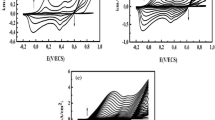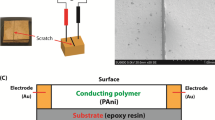Abstract
Polyaniline conductive thin films have been used for the detection of a number of important gases and vapors: organic solvents, ammonia, oxygen, hydrogen sulfide, nitrogen and sulfur oxides. The films can be produced by spin coating, thermal evaporation, the Langmuir–Blodgett technique and cyclic voltammetry. This paper presents preliminary results on acidity sensing with electrodeposited polyaniline layers. Polyaniline conductive thin films were prepared by anodic polymerization from an acidic solution of the monomer on two kinds of substrates: gold plated silicon and indium-tin oxide on glass. Ultraviolet-visible (UV-VIS) spectrometry of layers showed a maximum absorption peak around 800 nm for all the samples investigated (independent of preparation conditions) and revealed that the polymeric films were in the emeraldine base form, 18–25% protonated. The room-temperature in-plane d.c. conductivities of the polymer films were found to be between 4×10−9 S cm−1 and 9×10−10 S cm−1 (deposition rate approximately 4 μm h−1; film thickness 750–1100 nm). Immersion of the polyaniline films in dilute hydrochloric solution resulted in changes in the d.c. conductivity by up to nine orders of magnitude, reaching a value of 4×10−2 S cm−1 while immersed in the acidic solution. Humidity tests carried out by exposing polyaniline samples to water vapors changed the d.c. conductivity by one order of magnitude to 1.34×10−8 S cm−1.
Similar content being viewed by others
References
M. Trojanowicz, Electroanalysis 8 (1996) 233.
M. Lewenstam and W. Matuszemski, US Patent 5 498 323.
T. Hanawa, S. Kuwabata, H. Hashimoto and H. Yobeyama, Synth. Met. 30 (1989) 173.
M. M. Labes and O. N. Rudyj, J. Am. Chem. Soc. 85 (1963) 2055.
P. J. Reucroft, O. N. Rudyj and M. M. Labes, ibid. 85 (1963) 2059.
C. Hamann, G. Kampfrath and M. Mueller, Sens. Actuators B 1 (1990) 142.
A. Kitani and K. Sasaki, Surfaces 25 (1987) 71.
N. E. Agbor, M. C. Petty and A. P. Monkman, Sens. Actuators B 28 (1995) 173.
Y.-B. Shim, D. E. Stilwell and S.-M. Park, Electroanalysis 3 (1991) 31.
M. Trojanowicz, T. Krawcznski Vel Krawczyk, M. Zmorzynska and L. Campanella, Proceedings of Eurosensors XI, The Eleventh European Conference on Solid State Transducers (1997) 1157.
Y. Yang, E. Westerweele, C. Zhang, P. Smith and A. J. Haeger, J. Appl. Phys. 77 (1995) 694.
W. Jiakun and M. Hirata, Sens. and Actuators B 12 (1993) 11.
P. S. Barker, A. P. Monkman, M. C. Petty and R. Pride, IEE Proc. Circuits Devices Syst. 44 (1997) 111.
A. P. Monkman and P. Adams, Synth. Met. 40 (1991) 87.
G. E. Collins and L. J. Buckley, ibid. 78 (1996) 93.
Author information
Authors and Affiliations
Rights and permissions
About this article
Cite this article
Grigore, L., Petty, M.C. Polyaniline films deposited by anodic polymerization: Properties and applications to chemical sensing. Journal of Materials Science: Materials in Electronics 14, 389–392 (2003). https://doi.org/10.1023/A:1023908903260
Issue Date:
DOI: https://doi.org/10.1023/A:1023908903260




